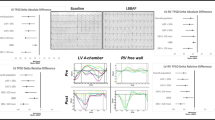Abstract
Prolonged RV pacing is recognized as a cause of LV dysfunction due to dyssynchronous activation. There are no specific longitudinal parameters known to help predict RV pacing-induced LV dysfunction. The aim of the study was to assess the acute effects of AV synchronous RV pacing on LV mechanics using echocardiographic speckle tracking. Nineteen children, aged 6–23 years, underwent echocardiographic evaluation prior to and following elective electrophysiology and ablation studies. The subjects were evaluated in sinus rhythm and later with AV synchronous RV pacing at a cycle length of 550 ms with a short AV delay of 80 ms. The echocardiographic clips were analyzed using speckle tracking methods to calculate LV circumferential and longitudinal strain, rotation and twist in all conditions. Acute RV apical pacing decreased LV longitudinal strain from 16.1 ± 3.7 % in sinus rhythm to 14.4 ± 3.3 % (p = 0.03) and LV base rotation from −8.4° ± 3.6° to −6.4° ± 4.0° (p = 0.04). The circumferential strain, apical rotation and LV twist were not affected. Separate analysis of subjects with no prior preexcitation showed that acute RV pacing caused significant twist reduction, from 15.9° ± 7.6° to 12.1° ± 7.0° (p = 0.02), and decreased longitudinal strain and base rotation. Patients with preexcitation had abnormalities that persisted acutely after ablation. Acute RV apical pacing causes reductions in LV base rotation, longitudinal strain and twist. The recognition of abnormal LV activation patterns may provide longitudinal clues to LV dysfunction in chronically paced patients and potential novel indices of effective CRT interventions to reverse these abnormalities.



Similar content being viewed by others
References
Dandel Michael (2009) Echocardiographic strain and strain rate imaging—clinical applications. Int J Cardiol 132(1):11–24
Epstein AE, Dimarco JP, Ellenbogen KA, Estes NA 3rd, Freedman RA, Gettes LS et al (2008) American College of Cardiology; American Heart Association Task Force on Practice Guidelines; American Association for Thoracic Surgery; Society of Thoracic Surgeons. ACC/AHA/HRS 2008 Guidelines for device-based therapy of cardiac rhythm abnormalities. Heart Rhythm 5(6):e1–e62
Fuchs E, Müller MF, Oswald H, Thöny H, Mohacsi P, Otto P, Hess OM (2004) Cardiac rotation and relaxation in patients with chronic heart failure. Eur J Heart Fail 6:715–722
Helle-Valle T, Crosby J, Edvardsen T, Lyseggen E, Amundsen BH, Smith HJ (2005) New noninvasive method for assessment of left ventricular rotation speckle tracking echocardiography. Circulation 112:3149–3156
Kass DA (2008) An epidemic of dyssynchrony: but what does it mean? J Am Coll Cardiol 51:12–17
Notomi Y, Lysyansky P, Setser RM, Shiota T, Popovic ZB, Martin-Miklovic MG et al (2005) Measurement of ventricular torsion by two-dimensional ultrasound speckle tracking imaging. J Am Coll Cardiol 45:2034–2041
Owen CH, Esposito DJ, Davis JW, Glower DD (1998) The effects of ventricular pacing on left ventricular geometry, function, myocardial oxygen consumption, and efficiency of contraction in conscious dogs. Pacing Clin Electrophysiol 21:1417–1429
Prinzen FW, Hunter WC, Wyman BT, McVeigh ER (1999) Mapping of regional myocardial strain and work during ventricular pacing: Experimental study using magnetic resonance imaging tagging. J Am Coll Cardiol 33:1735–1742
Rappaport D, Adam D, Lysyansky P, Riesner S (2006) Assessment of myocardial regional strain and strain rate by tissue tracking in b-mode echocardiograms. Ultrasound Med Biol 32:1181–1192
Rüssel IK, Götte MJ, Bronzwaer JG, Knaapen P, Paulus WJ, van Rossum AC (2009) Left ventricular torsion: an expanding role in the analysis of myocardial dysfunction. J Am Coll Cardiol Imaging 2(5):648–655
Shukla HH, Hellkamp AS, James EA, Flaker GC, Lee KL, Sweeney MO, Lamas GA, Mode Selection Trial (MOST) Investigators (2005) Heart failure hospitalization is more common in pacemaker patients with sinus node dysfunction and a prolonged paced QRS duration. Heart Rhythm 2(3):245–251
Sweeney MO, Hellkamp AS, Ellenbogen KA, Greenspon AJ, Freedman RA, Lee KL, Lamas GA, Selection Trial Investigators (2003) Adverse effect of ventricular pacing on heart failure and atrial fibrillation among patients with normal baseline QRS duration in a clinical trial of pacemaker therapy for sinus node dysfunction. Circulation 107:2932–2937
Tantengco MV, Thomas RL, Karpawich PP (2001) Left ventricular dysfunction after long-term right ventricular apical pacing in the young. J Am CollCardiol 37(8):2093–2100
Tops LF, Suffoletto MS, Bleeker GB, Boersma E, van der Wall EE, Gorcsan J 3rd et al (2007) Speckle tracking radial strain reveals left ventricular dyssynchrony in patients with permanent right ventricular pacing. J Am Coll Cardiol 50:1180–1188
Trajkov I, Poposka L, Kovacevic D, Dobrkovic L, Georgievska-Ismail L, Gjorgov N (2008) Cardiac memory (t-wave memory) after ablation of posteroseptal accessory pathway. Prilozi 29(1):167–182
Vassallo JA, Cassidy DM, Miller JM, Buxton AE, Marchlinski FE, Josephson ME (1986) Left ventricular endocardial activation during right ventricular pacing: effect of underlying heart disease. J Am Coll Cardiol 7:1228–1233
Author information
Authors and Affiliations
Corresponding author
Ethics declarations
Conflict of interest
The authors declare that they have no conflict of interest.
Rights and permissions
About this article
Cite this article
Tejman-Yarden, S., Bratincsak, A., Bachner-Hinenzon, N. et al. Left Ventricular Mechanical Property Changes During Acute AV Synchronous Right Ventricular Pacing in Children. Pediatr Cardiol 37, 106–111 (2016). https://doi.org/10.1007/s00246-015-1246-x
Received:
Accepted:
Published:
Issue Date:
DOI: https://doi.org/10.1007/s00246-015-1246-x




